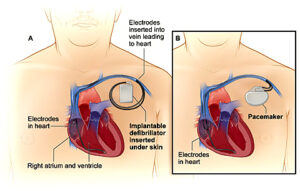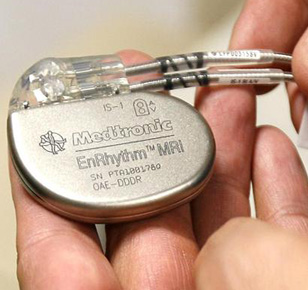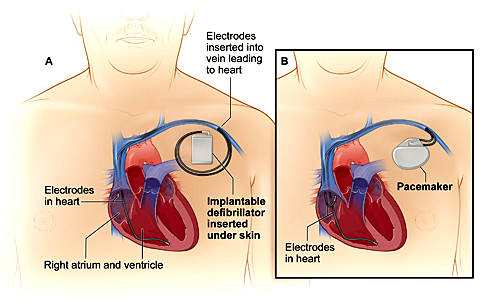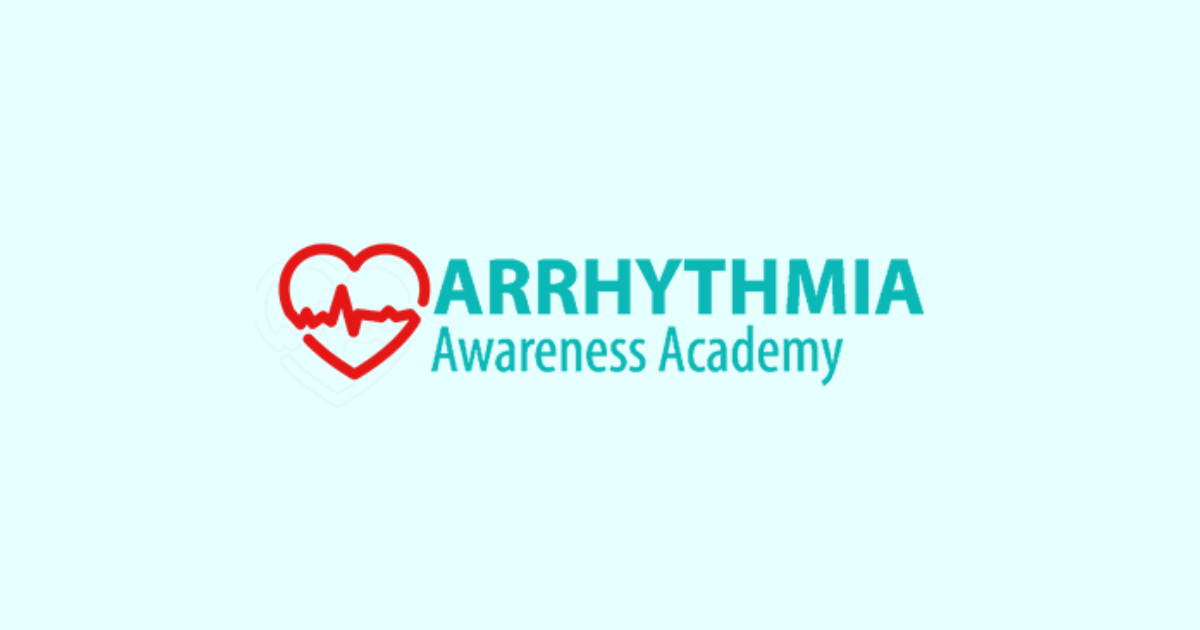What Is a Pacemaker?
A pacemaker is a small device that’s placed in the chest to help treat abnormally slow heart rhythms. This device uses electrical pulses to prompt the heart to beat at a normal rate.
Pacemakers are used to treat bradyarrhythmias. Arrhythmias are problems with the rate or rhythm of the heartbeat. During an arrhythmia, the heart can beat too fast, too slow, or with an irregular rhythm.
A heartbeat that’s too fast is called tachyarrhythmia . A heartbeat that’s too slow is called bradyarrhythmia..
During an arrhythmia, the heart may not be able to pump enough blood to the body. This may cause symptoms such as fatigue (tiredness), shortness of breath, or fainting. Severe arrhythmias can damage the body’s vital organs and may even cause loss of consciousness or death.
A pacemaker can relieve some arrhythmia symptoms, such as fatigue and fainting. A pacemaker also can help a person who has abnormal heart rhythms resume a more active lifestyle.
Understanding the Heart’s Electrical System
Your heart has its own internal electrical system that controls the rate and rhythm of your heartbeat. With each heartbeat, an electrical signal spreads from the top of your heart to the bottom. As the signal travels, it causes the heart to contract and pump blood.
Each electrical signal normally begins in a group of cells called the sinus node or sinoatrial (SA) node. The electrical signal passes from the sinus node to the AV node, which is the junction between the upper chambers, or atria, and lower chambers, or ventricles. As the signal spreads from the top of the heart to the bottom, it coordinates the timing of heart cell activity.
First, the heart’s two upper chambers, ie the atria contracts. This contraction pumps blood into the heart’s two lower chambers, the ventricles. The ventricles then contract and pump blood to the rest of the body. The combined contraction of the atria and ventricles is a heartbeat.
Overview
Faulty electrical signaling in the heart causes arrhythmias. A pacemaker uses low-energy electrical pulses to overcome this faulty electrical signaling. Pacemakers can:
- Speed up a slow heart rhythm.
- Help control an abnormal or fast heart rhythm.
- Make sure the ventricles contract normally if the atria are quivering instead of beating with a normal rhythm (a condition called atrial fibrillation).
- Coordinate the electrical signaling between the upper and lower chambers of the heart.
- Coordinate the electrical signaling between the ventricles. Pacemakers that do this are called cardiac resynchronization therapy (CRT) devices. CRT devices are used to treat heart failure.
- Prevent dangerous arrhythmias caused by a disorder called long QT syndrome.
Pacemakers also can monitor and record your heart’s electrical activity and heart rhythm.
Pacemakers can be temporary or permanent. Temporary pacemakers are used to treat temporary heartbeat problems, such as a slow heartbeat that’s caused by a heart attack, heart surgery, or an overdose of medicine.
Temporary pacemakers also are used during emergencies. They’re used until a permanent pacemaker can be implanted or until the temporary condition goes away. If you have a temporary pacemaker, you’ll stay in a hospital as long as the device is in place.
Permanent pacemakers are used to control long-term heart rhythm problems. Doctors also treat arrhythmias with another device called an implantable cardioverter defibrillator (ICD). An ICD is similar to a pacemaker in that it can treat abnormally slow heart rhythms. And also detects and treats abnormally fast, life-threatening heartbeats with pacing or shocks. Life-threatening abnormal heart rhythms, called ventricular tachycardia or ventricular fibrillation, may occur in patients with damaged heart muscle.
Who Needs a Pacemaker?
Doctors recommend pacemakers for a number of reasons. The most common reasons are bradycardia and heart block.
Bradycardia is a slower-than-normal heartbeat. Heart block is a problem with the electrical connection between the upper (atria) and lower (ventricles) chambers of the heart. The disorder occurs when an electrical signal is slowed or disrupted/interrupted as it moves through the heart.
Heart block can happen as a result of aging, damage to the heart from a heart attack, or other conditions that interfere with the heart’s electrical activity. Certain nerve and muscle disorders also can cause heart block, including muscular dystrophy.
Your doctor also may recommend a pacemaker if:
- Aging or heart disease damages your sinus node’s ability to set the correct pace for your heartbeat. Such damage can cause slower than normal heartbeats or long pauses between heartbeats (as discussed above). The damage also can cause your heart to alternate between slow and fast rhythms. This condition is called sick sinus syndrome.
- You’ve had an AV node ablation to treat an arrhythmia called atrial fibrillation. A pacemaker can help regulate your heartbeat after the procedure.
- You need to take certain heart medicines, such as beta blockers. These medicines may slow your heartbeat too much.
- You faint or have other symptoms of a slow heartbeat. For example, this may happen if the main artery in your neck that supplies your brain with blood is sensitive to pressure. Just quickly turning your neck can cause your heart to beat slower than normal. If that happens, not enough blood may flow to your brain, causing you to feel faint or collapse.
- You have heart muscle problems that cause electrical signals to travel too slowly through your heart muscle. (Your pacemaker may provide cardiac resynchronization therapy for this problem.)
- You have long QT syndrome, which puts you at risk for dangerous arrhythmias.
Children, adolescents, and people who have certain types of congenital heart disease may get pacemakers. Pacemakers also are sometimes implanted after heart transplants.
Before recommending a pacemaker, your doctor will consider any arrhythmia symptoms you have, such as dizziness, unexplained fainting, or shortness of breath. He also will consider whether you have a history of heart disease, what medicines you’re currently taking, and the results of heart tests.
How Does a Pacemaker Work?
A pacemaker system consists of a battery, a computerized generator, and wires with sensors called electrodes on one end. The battery powers the generator, and both are surrounded by a thin metal box. The wires connect the generator to the heart.
A pacemaker monitors and helps control your heartbeat. The electrodes detect your heart’s electrical activity and send data through the wires to the computer in the generator.
If your heart rhythm is abnormal, the computer will direct the generator to send electrical pulses to your heart. The pulses then travel through the wires to reach your heart.
The pacemaker’s computer also records your heart’s electrical activity and heart rhythm. Your doctor will use these recordings to adjust your pacemaker so it works better for you.
Your doctor can program the pacemaker’s computer with an external device. He or she doesn’t have to use needles or have direct contact with the pacemaker.
Pacemakers have one to three wires that are each placed in different chambers of the heart.
- The wires in a single-chamber pacemaker usually carry pulses between the right ventricle (the lower right chamber of your heart) and the generator.
- The wires in a dual-chamber pacemaker carry pulses between the right atrium (the upper right chamber of your heart) and the right ventricle and the generator. The pulses help coordinate the timing of these two chambers’ contractions.
- The wires in a biventricular pacemaker carry pulses between an atrium and both ventricles and the generator. The pulses help coordinate electrical signaling between the two ventricles. This type of pacemaker also is called a cardiac resynchronization therapy (CRT) device.

Types of Pacemaker Programming
The two main types of programming for pacemakers are demand pacing and rate-responsive pacing.
A demand pacemaker monitors your heart rhythm. It only sends electrical pulses to your heart if your heart is beating too slowly or if it misses a beat. All pacemakers today function as demand pacemakers.
A rate-responsive pacemaker will speed up or slow down your heart rate depending on how active you are. To do this, the rate-responsive pacemaker monitors your sinus node rate, breathing, blood temperature, and other factors to determine your activity level.
Most people who need pacemakers to continually set the pace of their heartbeats have rate-responsive pacemakers.
During Pacemaker Surgery
Placing a pacemaker requires minor surgery. The surgery usually is done in a hospital. Before the surgery, an intravenous (IV) line will be inserted into one of your veins. Medicine will be given through the IV line to help you relax. The medicine also may make you sleepy.
Your doctor will give you medicine to numb the area where he or she will put the pacemaker so you don’t feel any pain. Your doctor also will give you antibiotics to prevent infection.
First, your doctor will place a needle in a large vein, usually near the shoulder opposite your dominant hand. Your doctor will then use the needle to thread the pacemaker wires into the vein and to the correct place in your heart.
An x-ray “movie” of the wires as they pass through your vein and into your heart will help your doctor place them. Once the wires are in place, your doctor will make a small cut into the skin of your chest or abdomen.
He will then slip the pacemaker’s small metal box through the cut, place it just under your skin, and connect it to the wires that lead to your heart. The box contains the pacemaker’s battery and generator.
Once the pacemaker is in place, your doctor will test it to make sure it works properly. He will then sew up the cut. The entire surgery takes about an hour.
After Pacemaker Surgery
Expect to stay in the hospital overnight or two days so that health care team can check your heartbeat and make sure your pacemaker is working properly.
For a few days to weeks after surgery, you may have pain, swelling, or tenderness in the area where your pacemaker was placed. The pain usually is mild, and over-the-counter medicines often can relieve it. Your doctor may prescribe additional pain medications.
You will need to avoid vigorous activities and heavy lifting or stretching with the affected arm for about a month after pacemaker surgery. You will need to avoid raising the affected arm above shoulder level for one month. Most people return to their normal activities within a few days of having the surgery.



